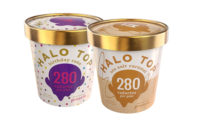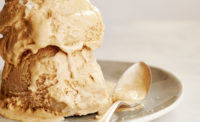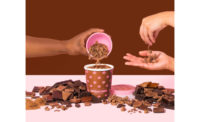There is a rising ice cream trend that may indicate where things are going for the ice cream category. With consumers’ growing interest in healthier indulgence, ice cream companies are creating pints that showcase fewer calories, less sugar and in some cases, a higher protein content. In a context where consumers are looking for indulgence and satisfaction from ice cream, those brands that are associated with a more premium identity, as well as simple, natural ingredients, are outperforming others, said global market research firm Mintel in a 2017 ice cream report.
Halo Top, Los Angeles, with its low-calorie, low-sugar and high-protein ice cream, currently corners the market on “healthy indulgence.” The brand had the best-selling pint of ice cream as of last summer, surpassing industry leaders such as Ben & Jerry’s and Häagen-Dazs, according to Halo Top. Its ice cream contains from 240 to 360 calories, an average of 5 to 8 grams of sugar and 20 grams of protein per pint. It is also made with sugar alcohol.
But other companies are coming forward with products that could take some share from Halo Top.
In February, Ben & Jerry’s, Burlington, Vt., introduced a line of reduced-calorie, reduced-sugar ice cream pints that gives its customers a “less guilt” option, the company said. Called Moo-phoria, the ice cream contains 60-70% less fat and at least 35% fewer calories than traditional ice cream, according to the company.
One of the line’s three flavors, Chocolate Milk & Cookies, features chocolate and vanilla light ice cream swirled with chocolate chip cookies. A ½-cup serving contains 140 calories, 4.5 grams of fat, 15 grams of sugar and 3 grams of protein.
Also in February, Talenti, Minneapolis, makers of gelato and sorbet, launched low-sugar gelato in three flavors: vanilla cinnamon, mint cookie and chocolate fudge swirl. The “crafted with less sugar” chocolate fudge swirl flavor contains 120 calories, 6 grams of fat, 9 grams of sugar, 6 grams of sugar alcohol (erythritol) and 4 grams of protein. The company also uses monk fruit in its recipe to help sweeten the gelato.
Huntington Beach, Calif.-based Revelé, meanwhile, makes a reduced-calorie, reduced-sugar whipped gelato, also sold in pints. The process of whipping air into the gelato makes it naturally lighter, with less sugar needed, according to the company. A ½-cup serving of the chocolate contains 90 calories, 4 grams of fat, 5 grams of sugar and 1 gram of protein.
“I expect to see many more ice cream companies riding the high-protein, low-calorie ice cream wave,” said Cary Frye, senior vice president of regulatory affairs for the Washington, D.C.-based International Dairy Foods Association (IDFA). “It’s an exciting trend because it means ice cream can be both an indulgent treat and an option for consumers looking to dessert for added nutrients.”
She added that in years past, ice cream companies responded to consumer requests by removing ingredients, such as in no-sugar-added and low-fat formulations. But today, companies are now adding ingredients that consumers want — for example, protein.
Keeping it clean
Another trend that is already unfolding and likely to shape the market going forward is the integration of more natural ingredients and simpler formulations, even as suppliers seek to keep products flavorful, satisfying and indulgent, Mintel said in its ice cream report.
Clean-label is the top trend guiding product development, according to a June 2017 ice cream survey by IDFA. Fifty-six percent of survey respondents listed clean labels (products made without artificial colors, preservatives and chemically derived ingredients) as key. Likewise, 44% of survey respondents listed natural products as a top trend.
Frye noted that clean labeling is here to stay.
“Many ice cream companies have already begun the lengthy process of reformulating and using new ingredients to achieve this trend,” she said. “I see added-sugars labeling as an exciting educational opportunity for ice cream companies. Companies should look to begin a conversation with the consumer about sugar’s role as an inherent and necessary ingredient in the making of a successful sweet treat.”
New eating occasions
Ice cream is well known as a go-to dessert option. But some companies are looking to expand ice cream’s eating occasions, capitalizing on the popular snacking movement. As companies such as Halo Top emphasize their products’ protein content, this snacking concept could gain steam.
“I think we will see products that pull from overarching trends in snacking,” said Dena Wimette, senior manager of innovation and communications for Ben & Jerry’s. “People are moving towards less formalized meal times and turn to snacks throughout the day. Ice cream is often a dessert item saved for after dinner and late night, so the question becomes how to bring ice cream into a snacking occasion.”
My/Mo Mochi Ice Cream, Los Angeles, is aiming to do just that. Last summer, the company launched a line of mochi ice cream, rice dough-covered ice cream that it’s marketing as portable sweet snacks. The hand-held frozen treats feature ice cream wrapped in sweet, soft dough, which makes them easy to eat on the go. The company recently expanded its line into pints, adding ice cream with mochi bits, featuring flavors similar to its dough-covered treats.
Wimette noted that products that solve consumers’ problems or provide a positive benefit have the best shot at success, as these supersede fads and trends.
Ben & Jerry’s tried to capitalize on the convenience/portable trend with its Pint Slices, introduced last summer. The round single servings of ice cream are covered in a chocolate coating. They are packaged in individually wrapped pouches (for easy on-the-go eating) and come in four flavors.
“People are leading increasingly busy lives and are looking for products and services to provide convenience,” Wimette said.






